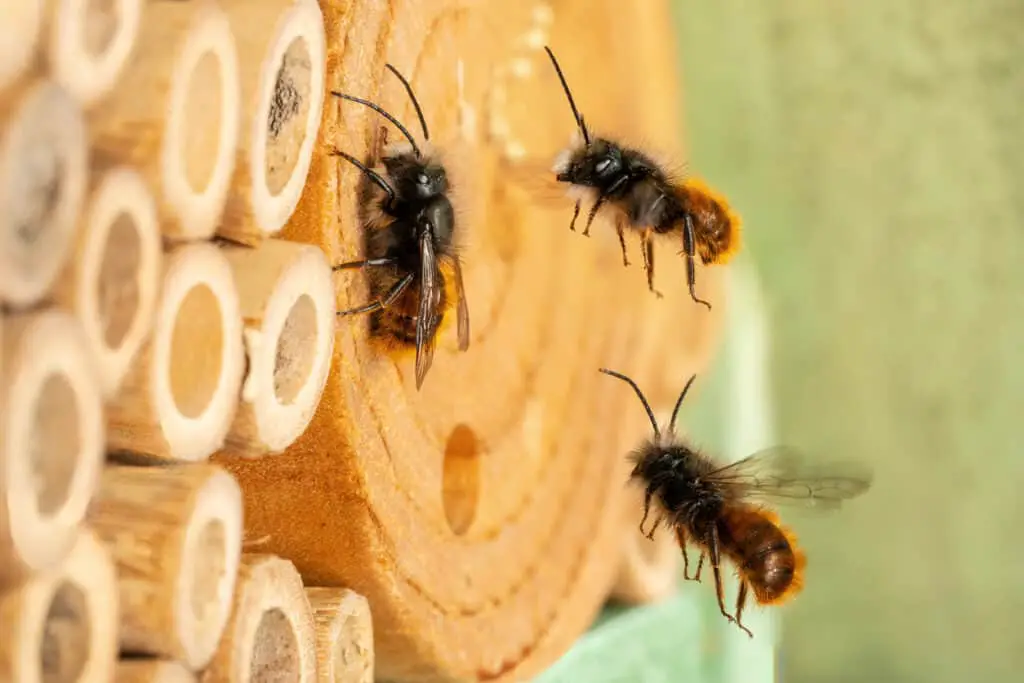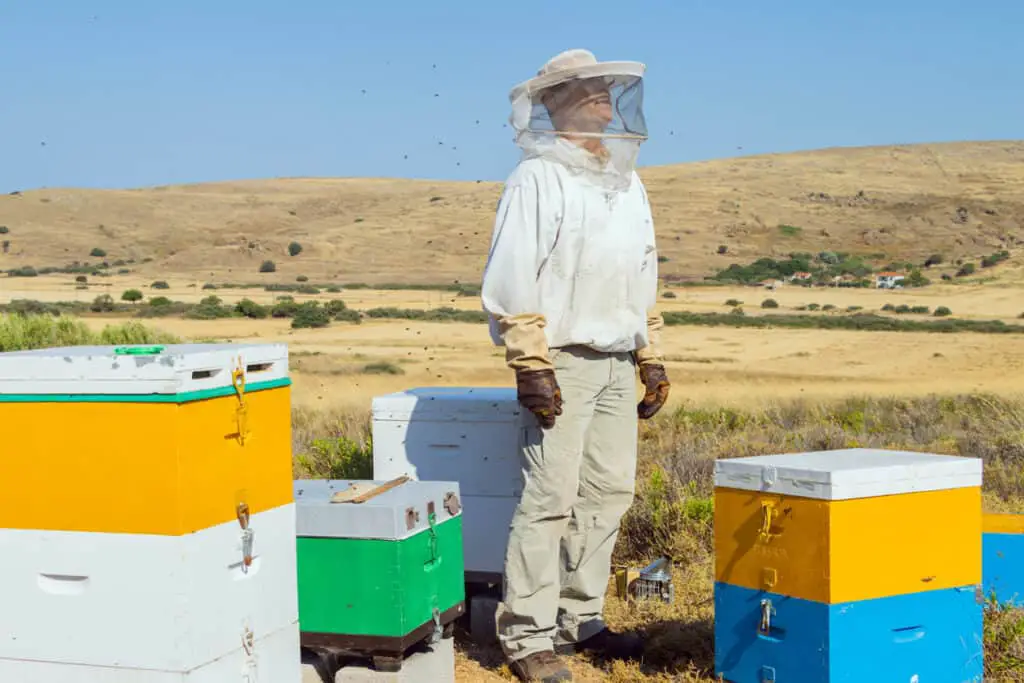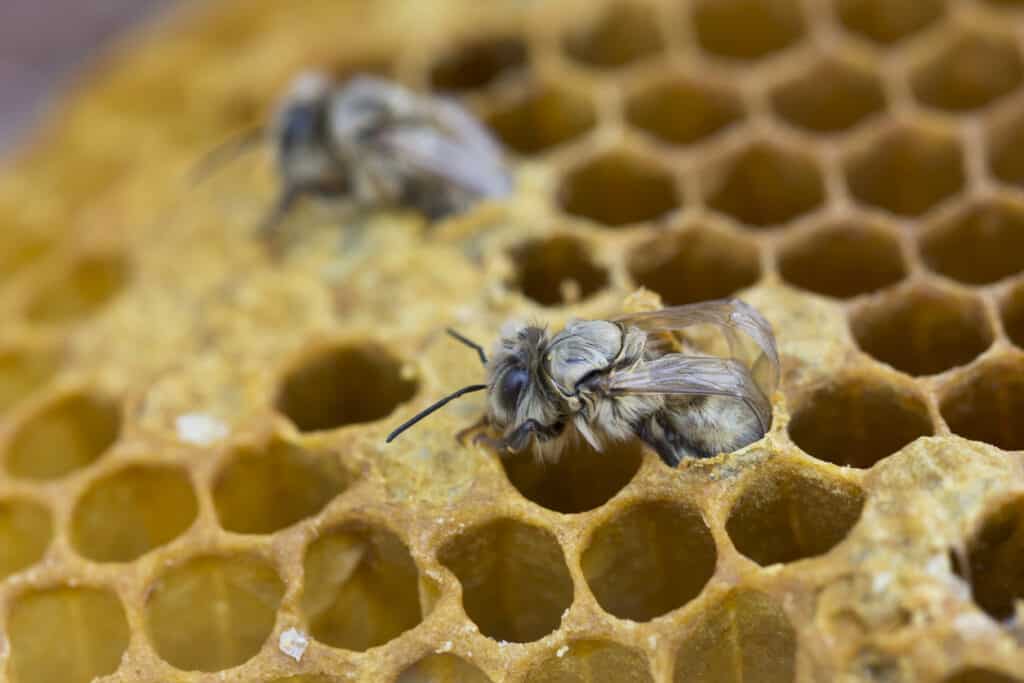Similar to most other living things on earth, bees are sensitive to temperature and changes in temperature. Just like humans, prolonged exposure to extreme temperatures can be potentially life-threatening to these lovable little bugs. Luckily, they have also built-up resilience to the extreme temperatures that the weather can present.
Your average honeybee is most active when the temperature is between 72° F to 77°. Still, they work efficiently between temperatures of 57° F to 100° F. Above or below the latter thresholds, honeybee flight becomes impaired, and the bees overheat or become drowsy.

Honeybees have developed many survival techniques to make it through the winter and capitalize on the good summer weather while it is still there. Still, quite similar to humans, honeybee workers run a sort of nine-to-five job ruled by the heat and light of the sun.
What Temperature Do Bees Come Out?

The daily life of bees is ruled by the temperature of the air, their bodies, and the hive. The temperature of the air determines their ability to maintain flight and consequently their ability to harvest nectar and produce honey.
Honeybee flight is most efficient when temperatures range between 72° F and 77° F. However, they will be equally inclined to work when the air’s temperature is between 57° F and 100° F. This provides a rather large interval wherein bees can effectively work. Still, it also shows why bees are not commonly seen in areas where temperatures can range to the extremes.
The minimum temperature at which honeybees can fly is around 54° F, and temperatures below 50° F could almost certainly mean the demise of any honeybees brave enough to fly out at the time. Honeybees have a minimum threshold for flight because their muscles can seize up under colder temperatures restricting the necessary movements for flight.
When bees’ muscles seize up and fall under this sort of “chill-coma,” they have about 50 hours of survival time left to heat up before they die from extreme cold exposure (if a predator hadn’t already spotted them). If the temperature around a honeybee falls below 28° F, they will die within an hour.
Bees generally leave their hive with a thorax (chest) temperature of around 93° F or more which naturally gets cooled down as they fly. When bees land on a flower, they bask in the sun (or try and absorb other sources of heat) while vibrating their muscles to produce heat for the flight home. When a bee’s thorax temperature drops below 77° F, flight becomes impossible, and the bee will likely die.
Although 50° F is generally accepted as the minimum temperature at which bees choose to venture outside of the hive, many sightings of bees would leave the hive when it is even colder. These should be regarded as anomalies because flying at these temperatures cannot be sustained for a long time since the wind rapidly cools down their thoracic temperatures.
Conversely, the maximum temperature at which honeybees can sustain flight is about 105° F, and anything more than 110° F will put the bees’ life at risk (that is, if they decide to leave the hive for harvesting). Furthermore, if honeybees feel too hot, they become lethargic and are less inclined to work (quite like us humans, really).
When outside temperatures become too extreme, honeybees stay inside; however, sometimes, it is necessary to venture outside despite the obvious risks – usually due to a shortage of food. In these cases, honeybees will make short trips (around 50 meters) outside their hive to collect nectar from nearby flowers.
What Temperature Do Other Types Of Bees Come Out?

There are many different subspecies of bees, and each has its characteristics, including factors that contribute to heat/cold sensitivity. As a result, different bees operate best at different temperatures. Below is a quick summary of the characteristics that influence at what temperature different bees tend to come out.
Bee Size Affects Their Optimal Flight Temperatures
Smaller-sized bees (such as honeybees) are more resistant to extreme temperatures than larger bees (such as carpenter bees). Carpenter bees, therefore, hibernate during the colder winter months and come out when temperatures rise around or above 70° F. Although the reason for this is not yet certain, it could be due to the larger surface of the body on which the temperature can take effect.
When scientists studied the effects of bee size on bumble bees, they found that larger bumblebees fare better in colder temperatures while smaller bees are better suited to warmer weather. Similarly, different species of bumble bees (that occur in different climates) point to the same conclusion: colder climates hosted larger bees, and warmer climates were home to smaller species of bumble bees.
Bumblebees, therefore, contrast the comparison found in carpenter bees, as they are roughly the same size, but bumblebees are more resistant to cold. Bumblebees (of all sizes) were found to thrive outside their dwelling, mostly between temperatures of 64° F and 91° F.
Bee Nesting Preferences Affect Their Preferred Temperature
Ground dwellers (bees that nest underground) are more resilient to extreme heat or cold since the underground temperatures of hives are often less affected by the outside temperature. These types of bees (such as carpenter and bumble bees) prefer hibernating throughout the winter and coming out in the early spring when temperatures are milder.
Due to the nature of their dwelling (and the fact that they tend to hibernate), these ground-dwelling bees are less likely to leave the hive under extreme weather conditions. The same goes for natural disasters, such as wildfires, as their dwelling is quite resistant to these occurrences.
Some bees nest above ground (in twigs, trees, hives, etc.), like your typical honeybee. These bees are more sensitive to extreme temperature changes within their dwelling. At higher levels of heat or cold, bees will venture out to drink water and bring some home for their special processes of thermoregulation.
What Temperature Do Bees Keep Their Nests?
The internal temperature of a honeybee’s nest must constantly measure around 89.6° F to 96.8°F. The reason is that the bee larvae and pupae cannot survive and keep growing outside of this range. Luckily, honeybees have developed many ways to manually maintain the perfect temperature within their hives.
Therefore, the reason why bees are sometimes reluctant to come out is not only because it could be dangerous for themselves, but rather because they must protect their offspring from extreme temperatures. They will, however, make short trips for thermoregulation.
How Do Bees Keep Their Nests At The Right Temperatures?
Thermoregulation is managed by using various techniques that depend on the goal of the heat regulation (whether the nest needs to be warmer or cooler). These techniques require a true hive mentality, and the colony works together like a well-oiled machine to ensure success.
How Do Bees Keep Their Nests Cool Enough?
When the outside temperature becomes too hot and reaches around 96° F, a group of worker bees will assemble at the entrances of the nest and fan their wings. The rhythmic fanning technique ensures a constant airflow throughout their home.
Simultaneously, another group of bees will go out of the nest on an expedition to find water. After sipping a bit for themselves, they will carry tiny droplets back to the nest and tactically place them all around the nest. These droplets evaporate, creating cooler air which eventually gets fanned around the nest by the other group.
Honeybees have a final technique to keep their hives’ internal temperature cool. This one is called “bearding,” named after the beard-like shape the colony forms on the outside of the hive. Essentially, bearding entails bees leaving the hive and sitting outside to allow the hive to cool down naturally due to the absence of body heat.
Bees keep this behavior (fanning and bearding) up as long as it takes for the hive to cool down back to normal. During the process, and depending on the external temperature, many bees can die from heat and exhaustion, especially if the heat wave is severe.
How Do Bees Keep Their Nests Warm Enough?
Suppose it becomes too cold during the winter or there is a surprise cold front, and the hive’s internal temperature threatens to drop below 90° F (or external air temperature drops to about 64°F). In that case, bees will implement strategies to keep their brood safe and warm. These techniques require a similar kind of teamwork as described above with fanning and bearding.
This time, the honeybees want to keep their hive warm enough to survive the winter. Honeybees do not hibernate; therefore, the colony needs a sufficient supply of honey/food to sustain them for the whole season. The amount they consume in winter is often more than they use over the summer months since the techniques used to warm up the nest are quite demanding.
The first step honeybees take to avoid their brood becoming hypothermic is to form a tight-packed cluster around the queen to keep her and the rest of the colony warm. If the external temperature becomes colder, the bees will cluster together even closer.
If these steps are not enough, the bees within the cluster will start vibrating their wing muscles fast to generate heat energy which becomes dispersed among one another and the nest. The outer layer of the cluster will remain still to form a sort of insulative layer.
The bees then take turns swapping around. The outside layer of the cluster will move to the very center to heat up quickly, while all the other bees will move one layer up. Now and then, the bees will also take turns eating to maintain optimal energy levels.
Many weaker colonies, however, have been seen to starve during the winter even though they had enough food. This phenomenon is seen because they were primarily unable to generate enough heat within the cluster to be able to move to the food source. As a result, the bees die one by one, unable to leave their comrades in an attempt to sustain themselves.
How Can You Help Bees Survive Extreme Temperatures?
Beekeepers and enthusiasts can help their local buzzing buddies in the summer by placing a shallow water source, such as a tray of water with some pebbles, near the bee nest. The water needs to be shallow, with some space for the bees to land on to prevent them from drowning. The bees will use this water for drinking to refresh themselves and further help in the fanning hive cooling process.
During extended heat waves, many plants and flowers may suffer. Planting sunflowers which are flowers with very long taproots may help bees survive the extreme heat. These flowers also produce a lot of the pollen and nectar essential for survival. Another viable option is lavender (which has the bonus of smelling very pleasant).
A simple way to aid your bees during the colder winter months is by providing them with sufficient (sugary) food for the winter. The ideal food option that is readily available in most areas is fondant. Bees love this sugary treat, and a block of fondant will sustain them throughout the winter. They need food mainly because they may not have enough honey to last winter, and food will be scarce.
Conclusion
Bees are very efficient little creatures. Although they are quite sensitive to different temperatures (especially the brood), they have also built a level of resilience in managing the crises that extreme summer and winter conditions can present. Global warming may exacerbate the usual seasonal fluctuations in temperature, but you can bee calm since these little critters make one hell of a team.

